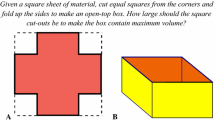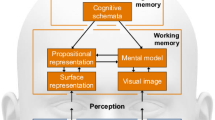Abstract
This paper describes a year-long study of the way a group of six 12-year-old children went about solving a special class of geometric problems, using a computer and a limited set of Logo programming tools. We examined children's solution strategies from the perspective of whether the strategies led to insights about the underlying mathematical relations. It was found that the “feedback” aspect of the computer graphics screen encouraged solution strategies that were qualitative and driven by visual data, rather than being based on explicit or implicit relations. These visually based strategies did not lead to the kind of mathematization of problem-situations that we as mathematics educators would like to see and, in fact, seemed to be a barrier to the development of higher levels of geometric thinking.
Similar content being viewed by others
References
Balacheff, N.: 1986, ‘Cognitive versus situational analysis of problem-solving behaviors’, For the Learning of Mathematics 6(3), 10–12.
Bell, A. W.: 1981, ‘The problem solving process’, in J. Hillel and D. Wheeler (eds.), Problem Solving Protocols: A Task-oriented Method of Analysis, Research Report, Concordia University, Montreal, Canada, pp. 110–133.
Hillel, J. and D. Wheeler: 1981, Problem Solving Protocols: a Task-oriented Method of Analysis, Research Report, Concordia University, Montreal, Canada.
Hillel, J. and C. Kieran: 1987, ‘Schemas used by 12-year-olds in solving selected Turtle Geometry tasks’, Recherches en Didactique des Mathématiques 8(1.2), 61–102.
Kieran, C., J. Hillel and S. Erlwanger: 1986, ‘Perceptual and analytical schemas in solving structured turtle-geometry tasks’, Proceedings of the Second International Conference for Logo and Mathematics Education, London, England, pp. 154–161.
Olson, A. T., T. E. Kieren and S. Ludwig: 1987, ‘Linking Logo, levels and language in Mathematics’, Educational Studies in Mathematics 18, 359–370.
Schoenfeld, A.: 1986, Students beliefs about Geometry and their effects on the student's geometric performance, paper presented at the Tenth International Conference of the Psychology of Mathematics Education, London, England.
Zykova, V. I.; 1969, ‘Operating with concepts when solving geometric problems’, in J. Kilpatrick and I. Wirszup (eds.), Soviet Studies in the Psychology of Learning and Teaching Mathematics 1, University of Chicago Press.
Author information
Authors and Affiliations
Rights and permissions
About this article
Cite this article
Hillel, J., Kieran, C. & Gurtner, JL. Solving structured geometric tasks on the computer: The role of feedback in generating strategies. Educational Studies in Mathematics 20, 1–39 (1989). https://doi.org/10.1007/BF00356039
Issue Date:
DOI: https://doi.org/10.1007/BF00356039




